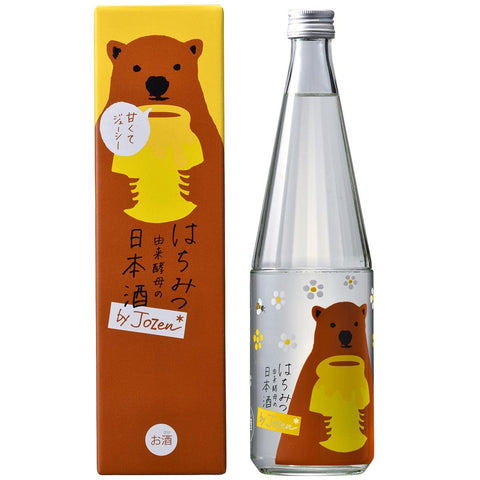
Honeybee on a plum blossom in Oakland on a spring day. Photo by Yoko
Some of you may know that I am a beekeeper. I’ve been keeping bees for about 10 years now. It is my passion outside of Umami Mart. So when I found out about honey yeast being used to ferment sake, I wanted to do everything I could to get it into the U.S. for Sake Gumi members. I couldn’t believe there was a bottle out there which encapsulated my two passions: bees and sake! Working directly with Daijiro Hosaka and Takaki Matsumoto of Shirataki Shuzo (who visited us in 2023) in Niigata, it took one year to get this sake into the U.S.
One of things I love about this sake is that it doesn’t just use any old honey they ordered off of Amazon. It’s honey harvested near the brewery by a local beekeeper they know named Hiroshi Takahashi of Snow County Honey. As beekeepers we know the world around us is changing and keeping bees seems to get harder as environmental changes confront us year after year. Takahashi faces yet another challenge that we don’t have to deal with here in California – cold, harsh winters. But these freezing conditions make way for unique blooms including acacia and horse chestnut in addition to the luminous cherry blossoms that blanket Japan in the spring time.
Speaking of cherry blossoms, Level 2 gets a sake made with sakura yeast from Tajima Shuzo. Yujiro Tajima, the toji at Tajima Shuzo says that the yeast is cultivated in-house. And while you can get a floral hint on the nose, I detect banana and caramel notes in the forefront. Tajima-san says that to create a sake that goes well with food, he wanted the assertiveness of yeast No. 7, but with more complexity, and found that the sakura yeast delivered these qualities. And to echo the sentiments of Amabuki Shuzo, who we featured last month, Tajima-san says, “By using sakura yeast, we have become a one-of-a-kind brewery that can produce sake without using association yeast.”
I hope you enjoy these unique sakes made with yeasts cultivated outside of the Brewing Society of Japan, aka the big brother of sake yeast. By exploring these yeasts for the past two months, I’ve developed a new appreciation for sake makers who are thinking outside of the box to bring us more diversity in sake. It’s hard work that is inspiring.
Hosaka-san of Jozen Shuzo created a little gift especially for Gumi members this month – a keitai (cell phone) strap with the honey bear logo on it. Strap in on with pride!
Fun fact, there are at least three beekeepers (including myself) in Sake Gumi! If you are a beekeeper or interested in keeping bees, please let me know – let’s talk bees and sake.
Yoko (Co-Founder, Umami Mart)

Jozen Honey-Derived Yeast Junmai
Shirataki Shuzo (Niigata, Japan)
Seimaibuai: Koshi Ibuki 60%, SMV: -70, Acidity: 2.0, Yeast: Honey-derived
Because the honey yeast is not as robust as certain sake yeasts, the resulting sake has a lower alcohol content of 8%. Balancing the sweetness with acidity, this sake drinks like a vermouth. Kayoko says it reminded her of Lillet Blanc and made a delicious cocktail combining 1 oz of this sake with 1 oz of gin and a twist of lemon. It was a delightful aperitif! With earthy of notes of honey complemented with aromas of tart orange and yogurt, you can enjoy a complexity of flavors in each sip. However, because of the lower alcohol and crisp acidity, this sake ends clean and light. That light ending was a great pairing with grilled zucchini and squash. Have this sake chilled in a wine glass.

Happy Owl “En” Yamahai Junmai
Tajima Brewery (Fukui, Japan)
Seimaibuai: Gohyaku Mangoku 60%, SMV: +3, Acidity: 1.6, Yeast: Sakura Flower
This lightly golden yamahai junmai is a great food pairing sake.Brewer Yujiro Tajima says of the yeast used to make this sake, “We received the yeast directly from the creator of flower yeast, Professor Hisayasu Nakata. After getting the yeast from Nakata-san, we’ve carried out the cultivation in-house.” Made with sakura yeast, an isoamyl acetate-type yeast that emits banana-like aromas, this sake has a lingering finish that has flavors of cooked rice and savory bitterness. These assertive flavors are delicious with foods that are mouth-watering – like umeboshi or thinly sliced cuts of roast beef or steak. Enjoy at room temperature or warm in a ceramic cup.
Sake Gumi is our monthly sake subscription service with 150 members throughout the country. Join today!




Comments (0)
There are no comments for this article. Be the first one to leave a message!